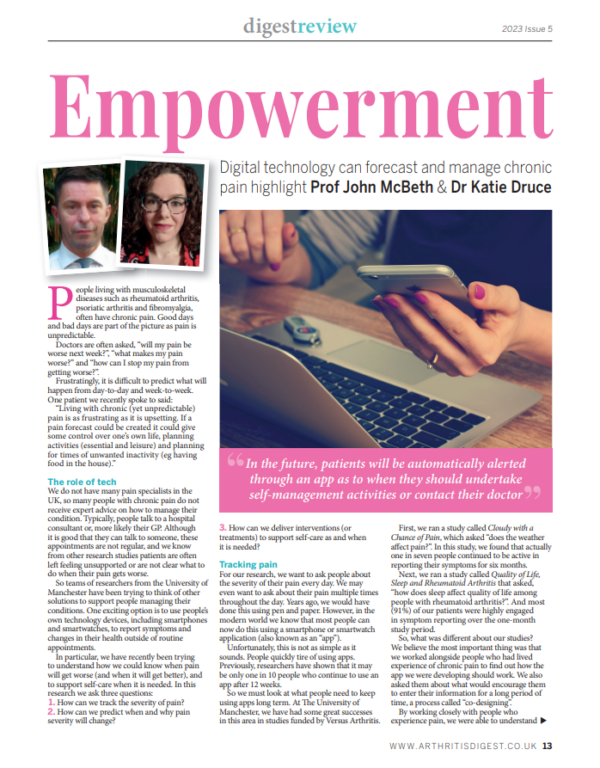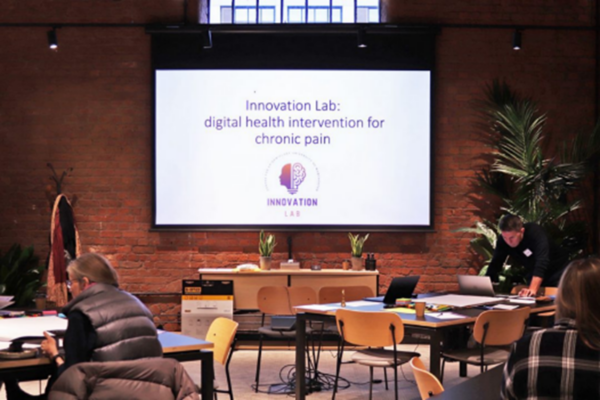Using digital technologies to forecast and manage chronic pain – Professor John McBeth and Dr Katie Druce speak to Arthritis Digest
Arthritis Digest is a magazine for people with arthritis that highlights the latest relevant research and reviews topical issues. Continuing regular contributions from our researchers, Professor John McBeth and Dr Katie Druce highlight how digital technology can forecast and manage chronic pain, which can empower patients living with musculoskeletal disease.
Prof McBeth is Professor of Chronic Disease Epidemiology at the Centre for Epidemiology Versus Arthritis at The University of Manchester (UoM), and Programme Lead for the Rheumatic and Musculoskeletal Diseases Theme at the NIHR Manchester Biomedical Research Centre (BRC). Dr Katie Druce is a Research Fellow at the Centre for Epidemiology Versus Arthritis and co-leads the UoM and Manchester BRC Fatigue and Cognition Research Group.
People living with musculoskeletal diseases such as rheumatoid arthritis, psoriatic arthritis and fibromyalgia, often have chronic pain. Good days and bad days are part of the picture as pain is unpredictable.
Doctors are often asked, “will my pain be worse next week?”, “what makes my pain worse?” and “how can I stop my pain from getting worse?”.
Frustratingly, it is difficult to predict what will happen from day-to-day and week-to-week. One patient we recently spoke to said:

Living with chronic (yet unpredictable) pain is as frustrating as it is upsetting. If a pain forecast could be created it could give some control over one’s own life, planning activities (essential and leisure) and planning for times of unwanted inactivity (eg having food in the house).
The role of tech
We do not have many pain specialists in the UK, so many people with chronic pain do not receive expert advice on how to manage their condition. Typically, people talk to a hospital consultant or, more likely their GP. Although it is good that they can talk to someone, these appointments are not regular, and we know from other research studies patients are often left feeling unsupported or are not clear what to do when their pain gets worse.
So teams of researchers from The University of Manchester have been trying to think of other solutions to support people managing their conditions. One exciting option is to use people’s own technology devices, including smartphones and smartwatches, to report symptoms and changes in their health outside of routine appointments.
In particular, we have recently been trying to understand how we could know when pain will get worse (and when it will get better), and to support self-care when it is needed. In this research we ask three questions:
- How can we track the severity of pain?
- How can we predict when and why pain severity will change?
- How can we deliver interventions (or treatments) to support self-care as and when it is needed?
Tracking pain

For our research, we want to ask people about the severity of their pain every day. We may even want to ask about their pain multiple times throughout the day. Years ago, we would have done this using pen and paper. However, in the modern world we know that most people can now do this using a smartphone or smartwatch application (also known as an “app”).
Unfortunately, this is not as simple as it sounds. People quickly tire of using apps. Previously, researchers have shown that it may be only one in 10 people who continue to use an app after 12 weeks.
So we must look at what people need to keep using apps long term. At The University of Manchester, we have had some great successes in this area in studies funded by Versus Arthritis.
First, we ran a study called Cloudy with a Chance of Pain, which asked “does the weather affect pain?”. In this study, we found that actually one in seven people continued to be active in reporting their symptoms for six months. Next, we ran a study called Quality of Life, Sleep and Rheumatoid Arthritis that asked, “how does sleep affect quality of life among people with rheumatoid arthritis?”. And most (91%) of our patients were highly engaged in symptom reporting over the one-month study period.
So, what was different about our studies?
We believe the most important thing was that we worked alongside people who had lived experience of chronic pain to find out how the app we were developing should work.
We also asked them about what would encourage them to enter their information for a long period of time, a process called “co-designing”. By working closely with people who experience pain, we were able to understand the problems people might have with the app and solutions they may need. From this work, we were able to understand there are a number of key factors to consider when designing an app:
- How easy is it to understand and use the app?
- What are the physical requirements of people using the app?
- How much time and effort will it take?
- How will people be reminded to enter the data?
- What information will people receive during and after the study?
- What support will be made available to people and how will they access it?
Although these questions stand alone, they all come about because the studies we have developed tend to ask people about their pain (at least once) every day. This means that to understand the pain being experienced by people we have to put some burden on people to provide their information. An additional problem is that many people are worried that it will make them focus on their pain and make it worse.
For that reason, we have been asking “would it be possible to understand the pain someone is experiencing without them even telling us?”. We are aware this sounds a bit far-fetched. But we know from other conditions, such as Parkinson’s disease, that it is possible to use the clever sensors in your smartphone and smartwatch to detect changes in the body that people are not even aware of. What this means is we may be able to identify increases in pain severity by looking at increased heart rate, or changes in the way people move. These changes are called “digital biomarkers”.

Predicting pain
The next question is whether we can predict what will happen to someone’s pain in the future? You can think about this a bit like a weather forecast, where you are told a few days in advance what you are likely to experience in the next three to five days, or beyond. Much like the weather, there are lots of different issues you might want to know about. The first step is to understand what exactly patients would want and need from a pain forecast.

To answer this, we worked with patients to co-design the content of a pain forecast. We spoke to 12 people about what they would want and need from a forecast, as well what the benefits and drawbacks would be of having this type of advanced information about their pain. Although these discussions were helpful, to make sure our findings were relevant for other people, we check them with a larger group of patients who live with chronic pain. To do this we developed a survey, and asked other patients to tell us about what they thought about the content of the co-designed forecast.
The survey results were clear. Patients valued knowing about the timing and severity of possible pain flares. Understanding the severity of pain was important, as was being able to use the forecast to make plans in daily life.
Interventions
The final piece of the research puzzle is for us to understand if it is possible to support patients to manage their pain using these same digital technologies. What this could mean is that if the information people send via the app indicates they are about to experience an increase in pain severity, they could be automatically alerted through their app and recommended to undertake certain self-management activities, or, if needed, to contact their doctor.
Our hope is that by doing this we can help prevent pain becoming more severe, or help lessen the impact on people when it does become severe.
To broaden our understanding, we held a two-day event called an “innovation lab” funded by the National Institute for Health and Care Research (NIHR) Manchester Biomedical Research Centre. In our Innovation Lab we spoke to people living with chronic pain, doctors, researchers and digital experts. Each person was asked what type of support should be offered in our research studies. The decision was that the support needed to be called “just in-time adaptive intervention” (JITAIs). This intervention is a special type of support which uses the information provided by patients to identify when support is most needed and what type of support should be offered.

For example, let’s say someone is wearing a smartwatch that can sense when they have been less active than usual and are likely to have more severe pain the following week. If the smartwatch notices this, it might gently buzz and show a message like “hey, it’s time to take a short walk!”. This support comes “just-in-time” because it happens exactly when it is needed, and it is “adaptive” because at that specific moment the advice that is most beneficial is a walk. In two to three days it may be that instead the advice would be to see a doctor, because a walk would no longer prevent the pain from getting worse.
This type of support is particularly exciting because it can be personalised, meaning it is unique to each person’s needs and preferences. You can choose what kind of support you want and how often you receive it.
Pain forecast and management
Digital technologies give exciting opportunities to help patients manage chronic pain in a way that complements the advice and treatment provided by healthcare professionals.
Crucially, we could not develop this new approach without the involvement of people living with chronic pain and their carers who are involved at every stage of our research from initial planning, through running the studies to understanding the results. Our goal is to ensure that what we do is meaningful and helpful and to ultimately improve the lives of people living with chronic pain.